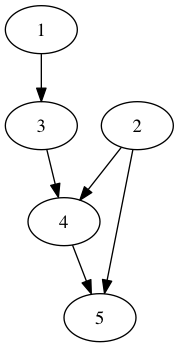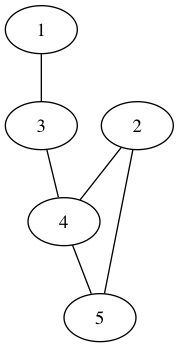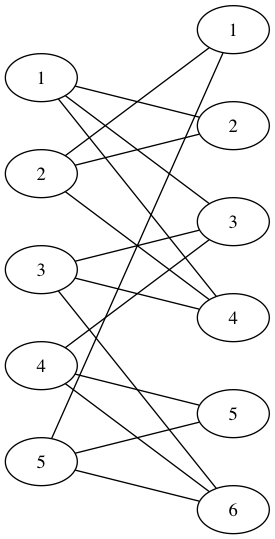CNFgen - graph formats
CNFgen
Combinatorial benchmarks for SAT solvers
The structure of some formula recipes in cnfgen is based on
graphs, which can be either simple undirected graphs, biparite
graphs, directed graphs or dag (directed acyclic graphs). It is
possible either to read graphs from files or to generate them
internally. The cnfgen tool accepts and saves graphs in the
following file formats.
- GML format (specification)
- DOT format if
NetworkXlibrary supports it (specification) - DIMACS edge format (specification)
- KTH adjacency list format (specification)
- Matrix format (specification)
Different file formats are suitable for specific graph types, as shown in this table.
| Graph type | Description | GML | DOT | KTH lists | DIMACS | Matrix |
|---|---|---|---|---|---|---|
simple |
simple undirected graph | Yes | Yes | Yes | Yes | No |
digraph |
directed graph | Yes | Yes | Yes | Yes | No |
dag |
directed acyclic graph | Yes | Yes | Yes | No | No |
bipartite |
bipartite graphs | Yes | Yes | Yes | No | Yes |
If the file ends with one of the extensions .kthlist, .gml,
.dot, .matrix, .dimacs then the program assumes that the file
is the corresponding format, otherwise it is always possible in the
command line to add the file format before the file name to avoid
ambiguity. This is particularly useful when the graph is read from
standard input or written on the standard output, or when the file
extension does not match its file format.
Encoding
cnfgen assumes that given graph files encoded as UTF-8.
Likewise it saves graph files in UTF-8 by default. In practice the
output is ASCII unless some explicit non-ASCII commentary text or
vertex/edge properties has been attached to the graph.
GML and DOT format — bipartite graphs representation
KTH adjacency list format
[ Full specification by Jakob Nordström ]
The kthlist adjacency list graph format has been introduced by
Jakob Nordström of the Proof Complexity research group at KTH Royal
Institute of Technologyas as an efficient and simple way to
represent sparse graphs for applications in SAT solving and
proof complexity.
The format can specify all four types of graph, but the exact interpretation of the file depends a bit on the context.
KTH predecessors list format — digraph
The kthlist format as a straightforward interpretation as
a directed graph, as described in the format specification.
KTH adjacency list format — dag
When CNFgen expects a directed acyclic graph, it expects the file
in kthlist format to express very explicitly the topological
order of the vertices. Namely the sequence of \(1\),… ,\(n\) is
expected to be a topological order from sources to sinks of the
vertices, and formula constructions in CNFgen will respect
this order.
KTH predecessors list format — simple
For the file to represent a simple graph, a vertex \(v\) is listed in
the adjacency list of \(u\) if and only if \(u\) is listed in the
adjacency list of \(v\). If that is not the case, the file is
considered invalid. Nevertheless CNFgen is more liberal and
consider an edge \(\{u,v\}\) to be in graph when: (1) \(u\) is in the
list of \(v\), or (2) when \(v\) is in the list of \(u\), or (3) both.
Naturally all simple graphs generated by CNFgen are correct
kthlist files according to the strictest interpretation of
the format.
Here’s an example of how a graph with missing inverted edges is interpreted as an undirected graph. The file
c c This is a DAG of 5 vertices c 5 1 : 0 2 : 0 3 : 1 0 4 : 2 3 0 5 : 2 4 0
represents the directed acyclic graph

and the simple undirected graph

KTH predecessors list format — bipartite
The interpretation of a file as a bipartite graph is similar to the
one for undirected graphs, with the difference that the bipartition
is made explicit by listing just the adjacency lists of the
vertices on the left side. It should be stressed that any isolated
vertex on the left side must be listed with its zero neighbors
otherwise its position would be ambiguous. CNFgen expects all
vertices on the left side to be listed in order, without skipping
any of them. The neighborhood can be specified in any order, which
will be preserved and taken in account.
c listing only left side vertices (bipartite graph) 11 1 : 7 8 9 0 2 : 6 7 9 0 3 : 8 9 11 0 4 : 8 10 11 0 5 : 6 10 11 0
The difference with the undirected graph is specification is
important. Notice that according to the format spec the previous
example is not a correct kthlist file for an undirected graph
because it lacks the adjacency lists of the right side vertices
too. The following is the same graph, but encoded as an
undirected graph and it is not in the correct format when
a biparite graph is expected.
c listing left and right side vertices (undirected graph) 11 1 : 7 8 9 0 2 : 6 7 9 0 3 : 8 9 11 0 4 : 8 10 11 0 5 : 6 10 11 0 6 : 2 5 0 7 : 1 2 0 8 : 1 3 4 0 9 : 1 2 3 0 10 : 4 5 0 11 : 3 4 5 0

Matrix format
The matrix format is suitable to represent the adjacency matrix of a bipartite graph, where rows correspond to vertices on the left side and columns to vertices on the right side.
The file consists on two numbers r and c separated by
whitespace, followed by a whitespace separated sequence of zeros and
ones of length \(r\times c\). Here's a well formatted example.
5 6 0 1 1 1 0 0 1 1 0 1 0 0 0 0 1 1 0 1 0 0 1 0 1 1 1 0 0 0 1 1
which represents the bipartite graph
